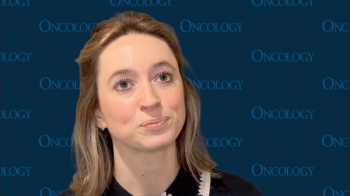
Treatment Options for Chronic and Steroid-Refractory GVHD
A detailed discussion on first-line treatment options for chronic GVHD and options for patients with steroid-refractory chronic GVHD.
Episodes in this series

Transcript:
Preet M. Chaudhary, MD, PhD: What are the first-line treatment options that you use for chronic GVHD [graft-vs-host disease]?
Eric Leon Tam, MD: For chronic GVHD, the first line of treatment typically is high-dose steroids and if the patient is off of immunosuppression like tacrolimus, we restart it. If they’re still on it, then we need to consider increasing the dose for these patients and that’s typically still the standard first-line treatment. For the second-line treatment, we have new therapies now but the second line and the sequencing of them can oftentimes be a little bit less standard and physician and practice-based.
Preet M. Chaudhary, MD, PhD: Does the site of the disease or the site of the organs which are involved with GVHD affect your treatment choice?
Eric Leon Tam, MD: It does, particularly if it’s steroid refractory. Steroids will typically work very well for most types of GVHD. We can consider certain times even a mild dose instead of a very large dose if it’s not very severe, but steroids seem to work very well for most types of organs, for most organ systems. When it’s steroid refractory and the steroid is not doing as much, or not improving as much, as we’d like then we definitely need to take into account the organ system that’s being affected.
There are certain therapies that seem to work a little bit better in certain organs. For example, ECP [extracorporeal photopheresis], which is a phototherapy usually works a little bit better for the skin and lungs in chronic GVHD. The new JAK [Janus kinase] inhibitor and the ROCK [Rho-kinase] inhibitor usually works a little bit better for multiple sclerosis as well, so lung GVHD, GI [gastrointestinal] GVHD, and the skin, they work very well for. Ibrutinib [Imbruvica], which is not very often used anymore, but seems to work very well in the skin but not so much in the other organ systems.
Preet M. Chaudhary, MD, PhD: Jakafi [ruxolitinib] seems to have an effect in most organs.
Eric Leon Tam, MD: Yes, it does. Jakafi and belumosudil [Rezurock] seem to have an effect in most organs.
Preet M. Chaudhary, MD, PhD: What are the main side effects that you see in patients who are on steroids?
Eric Leon Tam, MD: Steroids are a very heavy double-edged sword here, especially for our chronic GVHD symptoms. They have to usually stay on steroids for a long period of time. The main concern we always have with high-dose steroids for a long period is the patient getting an infection, so if they’re not already on it we have to restart antifungal prophylaxis, PJP [pneumocystis jiroveci pneumonia] prophylaxis and things like that.
Steroids can also wreak havoc on the body’s metabolism and its homeostasis as well, so weight gain. You mentioned the risk for infection. If they’re diabetic you could have very little diabetes when they’re on steroids too. It becomes a very holistic global approach for the patient once they’re on steroids.
Preet M. Chaudhary, MD, PhD: Some of the patients are steroid unresponsive and some are intolerant, and then some may be dependent on steroids. Can you talk a little bit about those different subtypes?
Eric Leon Tam, MD: Sure. Steroid intolerant means that because of the side effects from the steroids the patient is not able to tolerate it. So, for example, if the patient goes into very bad ketoacidosis from diabetes, even on a moderate dose of steroids, we have to rethink are steroids the best choice of therapy for them. Steroid refractory is when they’ve been on steroids for an amount of time, typically 7 to 10 days, if there’s still no improvement, or they’re still getting worse, then we consider that steroid refractory. Steroid dependent would mean they’ve responded. They’ve had a good response on the steroids. Now we’re trying to come down on steroids but every time we step down a dose their GVHD flares up. Those are all different ways that adjunctive therapy to steroids would be necessary.
Preet M. Chaudhary, MD, PhD: What are the treatment options for patients who are steroid refractory?
Eric Leon Tam, MD: For patients that are steroid refractory we have second- and third-line drugs that are approved for chronic GVHD. We have ruxolitinib, which is a JAK3 inhibitor, and this works in helping to inhibit certain subsets of lymphocytes, the immune system in a sense to prevent and stop the process of chronic GVHD. Recently approved in the last year was belumosudil, which is a ROCK2 inhibitor. It also affects a little bit in the JAK pathway but also has an auxiliary pathway where it helps with macrophage control so sometimes that helps with…
Lakshmi Savitala-Damerla, PA-C: TREC [T cell receptor excision circles] cells.
Eric Leon Tam, MD: And TREC cells sometimes helps with sclerosis as well.
Preet M. Chaudhary, MD, PhD: How successful are these agents in treating or controlling chronic GVHD?
Eric Leon Tam, MD: The ruxolitinib landmark trial was the REACH3 study for chronic GVHD, and compared to the best treatment for the standard of care 50% of patients had a response vs 26% of patients had a response. This is just any response. An overall response. It’s not a complete response. The majority of them are partial responses but still having something that we can add on in that sense was still helpful with the steroids.
Belumosudil, the landmark study for that was the ROCKstar study, and they had an overall response in the 70% range, but a majority of them were a partial response. I think only 2% to 5% were complete responses. There is hope that with additional therapy we can slowly improve the response of GVHD for these patients even if they’re still refractory. In the past, steroid-refractory chronic GVHD portended a very poor prognosis.
Lakshmi Savitala-Damerla, PA-C: It was a death sentence essentially.
Preet M. Chaudhary, MD, PhD: Also, I think it’s important to start the second-line agents quickly like Jakafi and other agents rather than waiting too long.
Eric Leon Tam, MD: Absolutely. Jakafi has I think a phase 2 study looking at early initiation of ruxolitinib in chronic GVHD and not waiting as the second line.
Preet M. Chaudhary, MD, PhD: How do you sequence a therapy, which agent if the patient is still refractory? What agent do you try first and how do you sequence it?
Eric Leon Tam, MD: That’s a very clinician-preference question. I think if you ask 100 oncologists, they’d give you 100 different answers because there are still additional therapies besides the 2 that I mentioned. We have ECP, we have T-cell depletion, so you can use cyclophosphamide. You can use alemtuzumab. We have other cytokine kinds of inhibitors. We have INF inhibitors, IL-2 inhibitors, and IL-6 inhibitors, so a lot of other options that are less standard but, at this point, I would still stick with what is approved and standard. So typically ruxolitinib or belumosudil would be my first choice. Of course, clinical trials, if available, can be considered. It depends on the organ systems that are involved as we had previously mentioned. If it was only skin, we might still consider ibrutinib if their cancer is stable.
Lakshmi Savitala-Damerla, PA-C: I was going to add to that. It really depends on the patient’s response too. Like you said, it’s hard to say this works or does not work, but usually by the time patients come to the chronic phase they’re usually on multimodality including tacrolimus, sirolimus, JAK2 inhibitors but also photopheresis. For some patients, when time is of the essence, they’re not able to fail that. When I educate patients, I always talk about photopheresis because it’s a nonmedication modality that over the long run has great outcomes if the patient is able to put in the time for phototherapy. I think it’s very underutilized, but I think it’s a great option for patients to consider.
Preet M. Chaudhary, MD, PhD: Generally speaking, for most patients, what’s your second-line preferred agent?
Eric Leon Tam, MD: Typically, it will be Jakafi.
Preet M. Chaudhary, MD, PhD: I think that’s the one that has the most experience at this point.
Lakshmi Savitala-Damerla, PA-C: The most data so far at least.
Transcript edited for clarity.
Newsletter
Stay up to date on recent advances in the multidisciplinary approach to cancer.




















































































